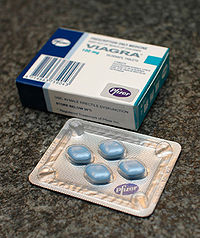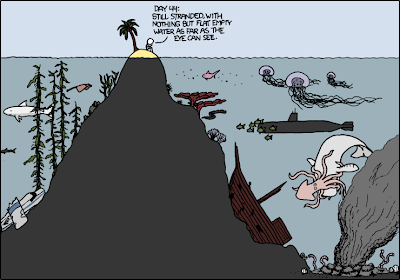
Not what it seems: Desert Island (click to enlarge the image). The obvious is sometimes hidden - this often applies to clinical evaluation of patients and research.
References:
http://xkcd.com/731



 Reduced saturated fat (SFA) consumption is recommended to decrease coronary heart disease (CHD), but there is an absence of strong supporting evidence from randomized controlled trials (RCTs) of clinical CHD events and few guidelines focus on any specific replacement nutrient. Additionally, some public health groups recommend lowering or limiting polyunsaturated fat (PUFA) consumption, a major potential replacement for SFA.
Reduced saturated fat (SFA) consumption is recommended to decrease coronary heart disease (CHD), but there is an absence of strong supporting evidence from randomized controlled trials (RCTs) of clinical CHD events and few guidelines focus on any specific replacement nutrient. Additionally, some public health groups recommend lowering or limiting polyunsaturated fat (PUFA) consumption, a major potential replacement for SFA.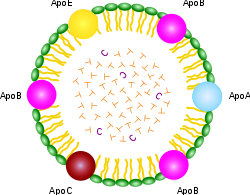 Homozygous familial hypercholesterolaemia is a rare genetic disorder in which both LDL-receptor alleles are defective, resulting in very high concentrations of LDL cholesterol in plasma and premature coronary artery disease. This study investigated the use of an antisense inhibitor of apolipoprotein B synthesis, mipomersen, to lower LDL cholesterol.
Homozygous familial hypercholesterolaemia is a rare genetic disorder in which both LDL-receptor alleles are defective, resulting in very high concentrations of LDL cholesterol in plasma and premature coronary artery disease. This study investigated the use of an antisense inhibitor of apolipoprotein B synthesis, mipomersen, to lower LDL cholesterol. In the future, diabetics may be able to wear contact lenses that continuously alert them to variations in their glucose levels by changing colors - potentially replacing the need to routinely draw blood throughout the day.
In the future, diabetics may be able to wear contact lenses that continuously alert them to variations in their glucose levels by changing colors - potentially replacing the need to routinely draw blood throughout the day. Low-dose combination therapy with rosiglitazone and metformin was highly effective in prevention of type 2 diabetes in patients with impaired glucose tolerance, with little effect on the clinically relevant adverse events of these two drugs.
Low-dose combination therapy with rosiglitazone and metformin was highly effective in prevention of type 2 diabetes in patients with impaired glucose tolerance, with little effect on the clinically relevant adverse events of these two drugs.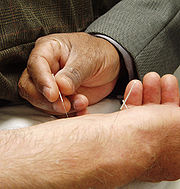 To prevent infections transmitted by acupuncture, infection control measures should be implemented, such as use of disposable needles, skin disinfection procedures and aseptic techniques.
To prevent infections transmitted by acupuncture, infection control measures should be implemented, such as use of disposable needles, skin disinfection procedures and aseptic techniques. 1. Make a list of your top health concerns.
1. Make a list of your top health concerns.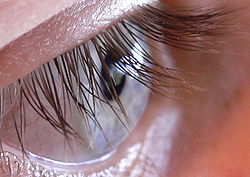
 The CDC study shows that six in 10 American adults were regular drinkers in 2005-2007, but only about three in 10 regularly exercised.
The CDC study shows that six in 10 American adults were regular drinkers in 2005-2007, but only about three in 10 regularly exercised.